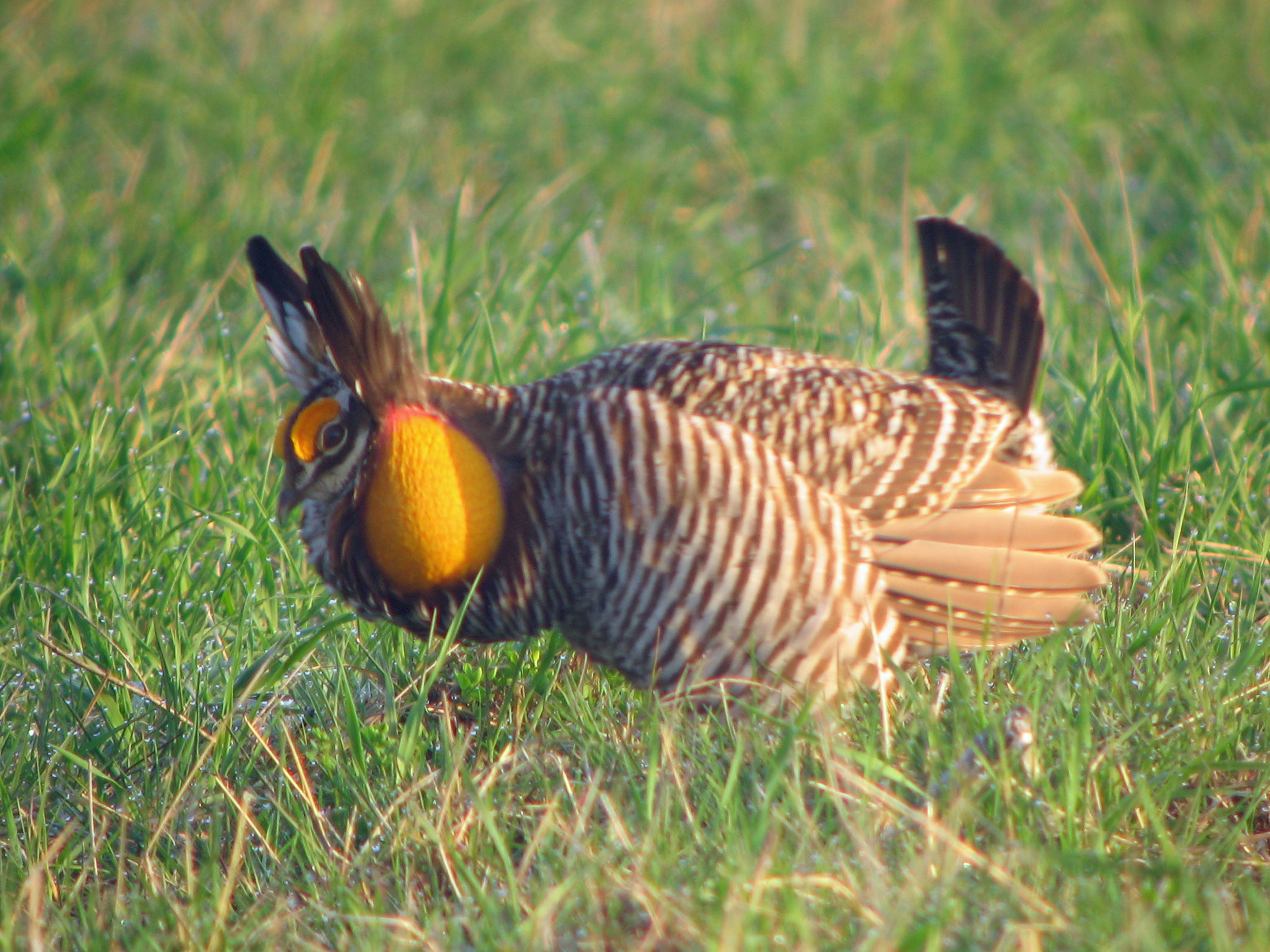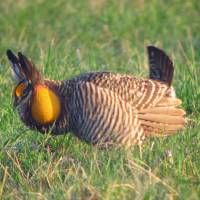Under an indigo predawn sky, as a frigid wind whipped across the plains, a half-dozen brown-and-white birds emerged from tufts of dry grass. They emitted a low cooing sound, akin to the hooting of an owl.
Then the greater prairie chickens started their show, scurrying around to mark their territory. When one encroached on another's turf, the defending animal charged, forcing the interloper to leap in the air with a flurry of feathers.
As the birds became more animated, the orange air sacs on each side of their necks swelled, allowing them to make a louder coo known as "booming."
The entire display had a single intended beneficiary — a female greater prairie chicken that selects the dominant male for mating — that never bothered to appear. It might have been too cold for her.
But the birds still had an audience: tourists sitting silently in a pair of parked yellow school buses with their windows cracked open. These humans may represent the prairie chickens' best chance for survival.
The northern Great Plains — 70 million hectares stretching across five states and two Canadian provinces — is one of the last three large swaths of grassland in the world, along with two in Mongolia and Patagonia.
Prairie chickens have roamed the Plains for millennia, but this region is under pressure from competing financial incentives to grow corn and soybeans, or pursue wind energy and shale-oil extraction.
Now an unlikely coalition of ranchers and environmentalists is working to keep the prairie intact and, in the process, preserve the animals and a traditional way of life.
As the country's prairie shrinks — U.S. farmers converted 500,000 hectares to corn and soybean fields between 2006 and 2011, according to a recent study — the birds who depend on it are increasingly imperiled. The birds, which include the greater and lesser prairie chicken as well as several species of sage grouse, are seen by scientists and federal officials as the best indicator of how the prairie is faring.
"They tell us what's happening in that particular ecosystem, because they're particularly sensitive," said U.S. Fish and Wildlife Service Director Daniel Ashe. "We want to keep the prairie right-side up."
But as the grasslands get plowed under for agriculture — already 95 percent of the nation's tall-grass prairie and about 60 percent of its short-grass prairie has been turned into farmland — the number of birds that breed and nest there is declining.
As a group, the nation's 41 grassland bird species have experienced a 38.4 percent population decline between 1968 and 2010, according to Dave Ziolkowski, ornithologist for the North American Breeding Bird Survey.
The Fish and Wildlife Service has proposed listing the lesser prairie chicken as threatened and the Gunnison sage grouse as endangered under the Endangered Species Act; it must reach a final decision on both species by September.
Now government officials are working with private landowners to devise voluntary land management plans that could prevent the listings altogether.
Texas Rep. Michael Conaway said that he has been encouraged by these efforts, but questioned whether the federal government would take into account the economic impact of species protection when making its final decision.
"The process is one thing, it's the result that everyone's interested in," Conaway said. "In western Texas there's distrust of the idea, 'I'm from the government, I'm here to help you.' "
And Ashe said it is hard to keep ranchers — who want to preserve grasslands to feed their cattle — on their land when federal requirements for ethanol production and crop insurance have made it more profitable to raise corn than cattle.
"Right now, what we're competing against is $8-a-bushel corn," he said. "It's frustrating, in a sense, because you feel like you're working against your own government."
And it explains why the Switzer family, a ranching family that has raised cattle on its property for 109 years, started the Nebraska Prairie Chicken Festival.
Now in its second year, the festival is a 2½-day celebration of the grassland birds that conduct one of the world's oddest mating rituals. Attendees learn the fine distinctions among the species: Greater prairie chickens gather on "booming grounds," Plains sharp-tailed grouse meet on "dancing grounds" and lesser prairie chickens get together on "gobbling grounds;" none are actually related to chickens.
After reciting the Pledge of Allegiance, getting photography tips and eating a meal of Wagyu beef raised on the neighboring ranch, more than 70 festival-goers eagerly get up before dawn the next morning to hide and watch the birds prance about Nebraska's Sandhills.
Steffi Jesseau, who teaches psychology at the University of Nebraska, Lincoln, and did graduate work in animal behavior, said she was amused to see so many male prairie chickens competing for a single female's attention.
"It's pretty hilarious, like with many species, the females were being coy," Jesseau said. "The males were quite earnest."
For the Switzers — Bruce and his wife, Sue Ann, who run Calamus Outfitters with their grown children Adam Switzer and Sarah Sortum — birding tours are an economic necessity.
Starting in the late 1990s, Sortum recalled, "I could really see my family struggling financially."
Twelve years ago, Adam decided to start a hunting lodge on the family's property to supplement income from ranching.
He launched it the same month as the Sept. 11, 2001, terrorist attacks; every guest canceled because it was impossible to travel with guns.
As a fallback plan, the Switzers started taking people on trips down the Calamus River running by their ranch. Then they realized that some tourists were interested in coming on their property in April to see birds dance.
"Now they're our favorite clientele," Sortum said. "They're interested in what's going on. And they're willing to pay, which is fabulous."
The Switzers have become fierce advocates for the greater prairie chicken ("I think they should be the state bird," Sortum said) and feel an obligation to keep it around.
"We can't blame the shrinking numbers on anyone else," Bruce Switzer said. "They live here year round. So it's our responsibility . . . It's our responsibility to save that bird."
World Wildlife Fund-U.S., which has focused on conserving the northern Great Plains, is working with the Switzers and other ranchers in the region to keep the landscape from being fragmented by farming, oil drilling and sprawl.
The environmental group took Bruce Switzer and Sarah Sortum to Namibia to observe wildlife safaris four years ago; now Sortum drives tourists across the Sandhills in an open jeep.
Jill Majerus, a conservation officer for WWF's Northern Great Plains program, said that she has learned that "people aren't going to protect their environment unless there's an economic tie to it."
Now ranchers elsewhere in Nebraska and in neighboring states have launched bird tour operations, and other prairie-chicken festivals have started as far away as Texas.
Tom Tabor, eco-tourism development consultant for the Nebraska Department of Economic Development, said this sort of activity "has great potential" to generate income in areas where "bird events are going on."
Even Nebraska Rep. Lee Terry, who has often feuded with environmentalists, said that he became intrigued by prairie chicken tourism after state officials pitched him on the idea a few weeks ago.
"I knew they existed. I had no idea that it was actually a destination stop," he said. "I think the state would like to save the prairie chicken, greater or lesser, as long as they keep dancing."


















With your current subscription plan you can comment on stories. However, before writing your first comment, please create a display name in the Profile section of your subscriber account page.